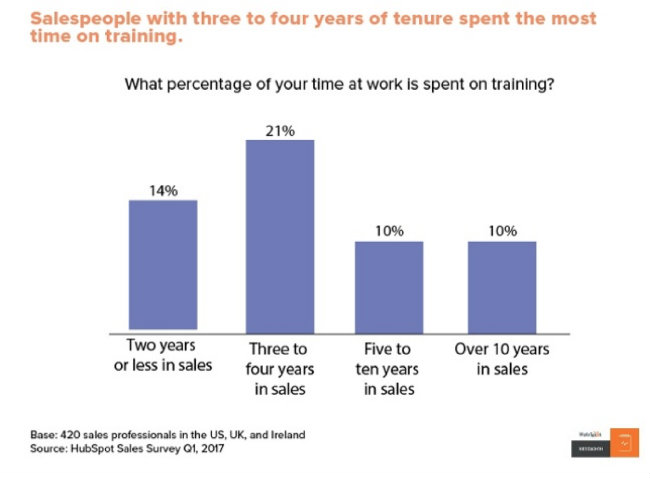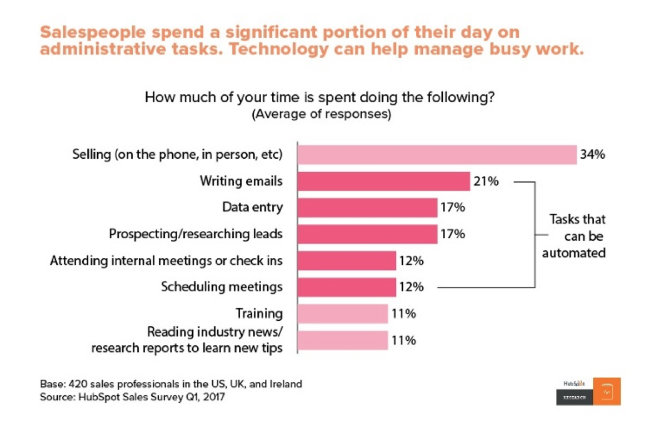 The modern sales department is one of the most motley groups of people you can meet inside an organization. Their job requires them, first and foremost, to build relationships with their customers, so their income is essentially based on how well they are liked by the people they are selling to. They come from a variety of educational backgrounds, and a sizeable chunk of your average sales force do not have a post-secondary education at all. Sales education boils down to helping your salesforce transform good relationships into great—and profitable—ones, and teaching them how to find the right leads and pursue them the right way.
The modern sales department is one of the most motley groups of people you can meet inside an organization. Their job requires them, first and foremost, to build relationships with their customers, so their income is essentially based on how well they are liked by the people they are selling to. They come from a variety of educational backgrounds, and a sizeable chunk of your average sales force do not have a post-secondary education at all. Sales education boils down to helping your salesforce transform good relationships into great—and profitable—ones, and teaching them how to find the right leads and pursue them the right way.
What unites them is the necessity to learn as much as they can to improve their sales process, whether that means refining their interactions with customers or learning how to ask for the sale directly. It could also mean becoming more informed on the products they’re selling, or learning how to nurture abandoned carts or relationships that may have enormous long-term payoff.
The underpinning factor of their engagement with the sales education process is what their motivation is to become a salesperson in the first place. Once you unlock your sales force’s individual motivations and sales experience, you can direct them toward the most effective style of sales education for their learning style.
The Two Sales Career Paths that Determine Education Style
People come to sales from a huge variety of educational and experience backgrounds, and that more than anything informs how they learn. Understanding how and why your salespeople got into sales as a career is important, as it will split the education process into two distinct paths: educating reluctant salespeople, and educating active, invested salespeople who seek out educational information on their own.

The Reluctant Salesperson
About 46 percent of your average team of sales professionals tumble to sales, because sales teams are often high-turnover workplaces and sales positions are frequently available. These are the folks who had to get a high-earning job out of financial necessity of some kind, but it’s not their “if I had a million dollars” job. This segment of the salesforce will require an entirely different support network, and will be heavily dependent on spoon-fed information such as at-work seminars and one-on-one support from their managers. In-house training for these folks must be especially spectacular and engaging: video content, prizes, fireworks, whatever you’ve got. It’s all on the table with the reluctant salesperson.
Women are more likely than men to say that they didn’t choose a sales career intentionally (55 percent vs 37 percent, respectively), and often benefit from a close supportive relationship with their managers as a main source of training, and both reluctant and active sales education styles benefit from knowledge-sharing events with their more experienced peers.
The Active Salesperson
When someone chooses to pursue a career in sales, they are much more likely to seek out external sources of sales training, such as conferences and one-off outside sales trainings. This group will be much more engaged and motivated to become better salespeople, as the pursuit of the sale aligns with their natural sense of goal completion and job satisfaction. In other words, your “chosen” sales reps like selling and it will make them happier to get better at their jobs.
These people merely need to be pointed toward helpful resources, so it’s essential to provide this group with a rich library of sales education resources and opportunities they can seek out on their own. From webinars to white papers, your most engaged salespeople will light their own rocket fuel if you arm them with the knowledge they need. It’s also beneficial to hold peer-lead trainings and informal group sessions, as peer networks rank the highest for both groups as their main source of sales process education.
Well, for a period of time, that is.
The Lifecycle of Sales Education
Once you have determined which salespeople are self-guided and which will need more hands-on education internally, training effectively becomes a matter of timing.

Too Early
Most new sales reps spend their first year in the job adjusting to the job itself before they start to seek out sales education in earnest. But after about one or two years, new reps reach the cruising altitude that allows them to focus on improving their sales performance once they feel confident in their product and internal processes knowledge. Managers may find barraging brand-new sales reps with excessive sales training may create information fatigue, and this training is often applied when the rep is not optimally engaged in the learning process.
In other words, don’t make the newbies drink from the proverbial fire hose and expect knockout sales professionals in a year.
Too Late
If you miss getting your best education in the first five-year window of experience, you may find it difficult to engage your salespeople in the education process. Research shows only about 10 percent of salespeople with more than 5 of years of experience seek out sales education and training, especially once they feel they have locked into a system that works for them. Fifty-nine percent of salespeople say that they do not change their sales process once they figure out what works for them personally.

The Sweet Spot
Sales professionals with three to four years of experience in the industry tend to spend the most time of any group on education, and they tend to be the most engaged in the process. At this point in their careers, they are confident in their ability to sell, but need outside resources and experience to get better. This is the time to bring the “non-career” salespeople in for one-on-one coaching and training, and to push the library of resources to your heavily-invested salespeople. Making the most of this crucial window is the difference between having a superstar salesforce built on confidence and a lukewarm salesforce chasing diminishing profits.
Speeding Up Education with Automation

Most salespeople will tell you large portions of their work time every day is wasted doing administrative tasks like responding to emails and manual data entry. If it sounds crazy to you in 2017, that’s because it is.
Automation can help free your sales reps from time-sucking processes like prospecting leads and scheduling meetings, and any CRM worth its salt should provide flexible email templates and automatic data collection that keep your salespeople doing what they were hired to do: sell your product.
Not to mention, the huge portion of time taken up by automation-ready processes could be spent making your salespeople better at their jobs. If they had five extra minutes a day to watch a well-produced, engaging, AV-heavy webinar or virtual sales training, imagine how much more effective they could be at their jobs. After all, that 21 percent of your average 9- to 10-hour sales day spent sending emails comes out to be about two hours your salespeople are not on the phones or meeting clients.
Making Education Work
Effective sales education is simply not a one-size-fits-all, quarterly PowerPoint presentation. To stay competitive, your sales reps have to be able to deliver a dynamic combination of information, confidence, and friendliness—all products of effective education and managerial support. To keep your salespeople engaged in the process, you should meet them halfway with their personal motivations and experience, and guide them from that point in the way best for them, and focus your strongest efforts on sales professionals with less than five years of experience. Some will require one-on-one coaching, while others will break out in a run to get a good seat for the group call session. It all depends on why they became salespeople in the first place, and how long they have been at it. The uniting factor is they need more time in their day to train, exchange tips, and get on the phones, and less time spent replying to emails and entering addresses.
Combining the human touch of customized educational plans with the ease of digital automation is the path that ensures your sales team will become a lean, mean, cash-generating machine.
Photo Credit: BearNo.18 Flickr via Compfight cc
This article was first published on The Marketing Scope.
